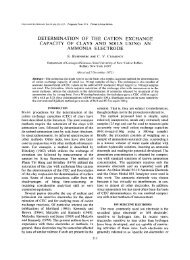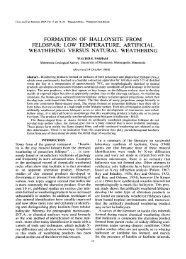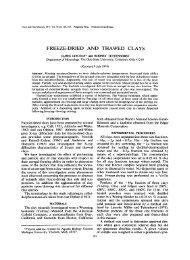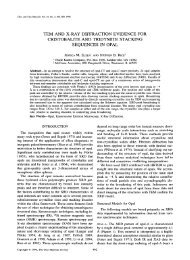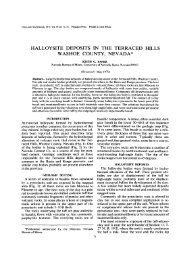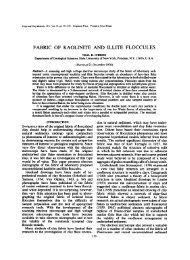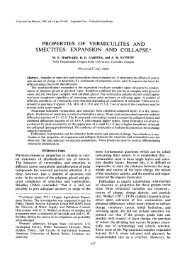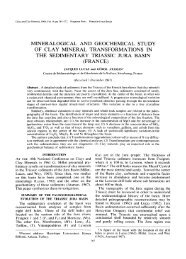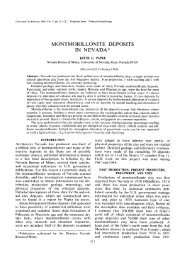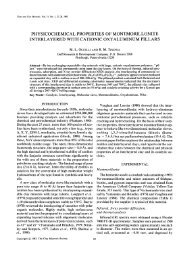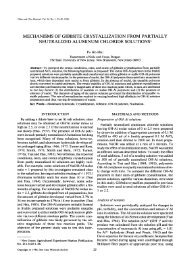the hydrophilicity and hydrophobicity of clay minerals
the hydrophilicity and hydrophobicity of clay minerals
the hydrophilicity and hydrophobicity of clay minerals
Create successful ePaper yourself
Turn your PDF publications into a flip-book with our unique Google optimized e-Paper software.
Clays <strong>and</strong> Clay Minerals, Vol. 43, No. 4, 474-477, 1995.<br />
THE HYDROPHILICITY AND HYDROPHOBICITY OF CLAY MINERALS<br />
C. J. VAN OSS 1 AND R. F. GIESE 2<br />
Department <strong>of</strong> Microbiology <strong>and</strong> Department <strong>of</strong> Chemical Engineering<br />
State University <strong>of</strong> New York at Buffalo, Buffalo, New York 14214<br />
2 Department <strong>of</strong> Geology, State University <strong>of</strong> New York at Buffalo<br />
Buffalo, New York 14260<br />
Abstract--The terms "hydrophobic" <strong>and</strong> "hydrophilic" are typically used in a non-specific sense <strong>and</strong>, as<br />
such, <strong>the</strong>y have a limited utility. Surface <strong>the</strong>rmodynamic <strong>the</strong>ory, as described here, allows a natural <strong>and</strong><br />
potentially powerful definition <strong>of</strong> <strong>the</strong>se terms. The boundary between <strong>hydrophobicity</strong> <strong>and</strong> <strong>hydrophilicity</strong><br />
occurs when <strong>the</strong> difference between <strong>the</strong> apolar attraction <strong>and</strong> <strong>the</strong> polar repulsion between molecules or<br />
particles <strong>of</strong> material (1) immersed in water (w) is equal to <strong>the</strong> cohesive polar attraction between <strong>the</strong> water<br />
molecules. Under <strong>the</strong>se conditions, <strong>the</strong> interfacial free energy <strong>of</strong> interaction between particles <strong>of</strong> 1, immersed<br />
in water (ignoring electrostatic interactions), AG[~I, is exactly zero. When AG~r~t is positive, <strong>the</strong><br />
interaction <strong>of</strong> <strong>the</strong> material with water dominates <strong>and</strong> <strong>the</strong> surface <strong>of</strong> <strong>the</strong> material is hydrophilic; when<br />
AGtw~<br />
IF<br />
is negative, <strong>the</strong> polar cohesive attraction between <strong>the</strong> water molecules dominates <strong>and</strong> <strong>the</strong> material<br />
is hydrophobic. Thus, <strong>the</strong> sign <strong>of</strong> AGlWwl defines <strong>the</strong> nature <strong>of</strong> <strong>the</strong> surface <strong>and</strong> <strong>the</strong> magnitude <strong>of</strong> AGI~<br />
may be used as <strong>the</strong> natural quantitative measure <strong>of</strong> <strong>the</strong> surface <strong>hydrophobicity</strong> or <strong>hydrophilicity</strong>.<br />
Key Words--Hydrophilic, Hydrophobic, Surface <strong>the</strong>rmodynamics.<br />
INTRODUCTION<br />
Much <strong>of</strong> <strong>the</strong> scientific <strong>and</strong> technological interest in<br />
<strong>clay</strong> <strong>minerals</strong> derives from <strong>the</strong>ir interfacial interactions<br />
with colloidal particles (<strong>clay</strong>s <strong>and</strong> o<strong>the</strong>r <strong>minerals</strong>) in<br />
<strong>the</strong> presence <strong>of</strong> a liquid, most <strong>of</strong>ten with water. The<br />
interracial properties, along with <strong>the</strong> electrostatic interactions,<br />
if any, control flocculation, adsorption, wetting,<br />
<strong>and</strong> <strong>the</strong>y are a major contributor to <strong>the</strong> rheological<br />
properties <strong>of</strong> dispersions. Thus, it would be useful to<br />
have a terminology to describe <strong>the</strong> manner in which a<br />
solid surface interacts with ano<strong>the</strong>r solid surface (e.g.,<br />
two <strong>clay</strong> mineral particles) in <strong>the</strong> presence <strong>of</strong> a liquid.<br />
It is commonly assumed that water wets <strong>the</strong> surface<br />
<strong>of</strong> a hydrophilic solid <strong>and</strong> does not wet <strong>the</strong> surface <strong>of</strong><br />
a hydrophobic solid (cf. <strong>the</strong> very designation "hydrophobic"<br />
(Adamson 1982)). If this nomenclature were<br />
true, it would have some utility, but it still would be<br />
purely descriptive <strong>and</strong> uninformative about <strong>the</strong> causes<br />
<strong>of</strong> <strong>the</strong> particular behavior described. There also is no<br />
indication <strong>of</strong> a scale <strong>of</strong> magnitude in this nomenclature,<br />
that is, <strong>the</strong>re are surfaces which are more hydrophobic<br />
than o<strong>the</strong>rs, yet <strong>the</strong> difference between two such surfaces<br />
cannot be quantified solely with <strong>the</strong> terms hydrophobic<br />
or hydrophilic.<br />
Now, wetting or non-wetting by water is actually a<br />
very unsatisfactory criterion: all surfaces <strong>of</strong> condensedphase<br />
materials attract water molecules to a considerable<br />
degree, i.e., with a free energy <strong>of</strong> adhesion varying<br />
from a value <strong>of</strong> -40 mJ/m 2 for strongly apolar<br />
surfaces, to - 140 mJ/m 2 for <strong>the</strong> most strongly hydrophilic<br />
materials (van Oss 1994). Thus, simply to designate<br />
apolar compounds as "hydrophobic" is inap-<br />
Copyright 9 1995, The Clay Minerals Society<br />
474<br />
propriate. However, as <strong>the</strong> use <strong>of</strong> that adjective in this<br />
context has become too wide-spread to hope for its<br />
speedy disappearance it should be used only in <strong>the</strong><br />
sense <strong>of</strong> "apolar", or "low-energy".<br />
Surface <strong>the</strong>rmodynamic <strong>the</strong>ory can describe <strong>the</strong> interactions<br />
between condensed-phase materials across<br />
an interface <strong>and</strong> thus provides a basis for a natural <strong>and</strong><br />
quantitative definition <strong>of</strong> <strong>hydrophobicity</strong> <strong>and</strong> <strong>hydrophilicity</strong>,<br />
in <strong>the</strong> form <strong>of</strong> <strong>the</strong> free energy <strong>of</strong> interfacial<br />
interaction between particles, in an aqueous environment<br />
(van Oss <strong>and</strong> Good 1988, Good <strong>and</strong> van Oss<br />
1991). Such a definition can reveal which properties<br />
<strong>of</strong> <strong>the</strong> materials <strong>and</strong> <strong>of</strong> <strong>the</strong> liquid medium are responsible<br />
for <strong>the</strong> interracial behavior.<br />
BACKGROUND<br />
Non-covalent interactions between particles are <strong>of</strong><br />
three types: 1) interfacial interactions, 2) electrostatic<br />
interactions, <strong>and</strong> 3) Brownian movement (van Oss<br />
1994). Of <strong>the</strong>se, only <strong>the</strong> interfacial interactions are<br />
relevant to a definition <strong>of</strong> <strong>hydrophobicity</strong> <strong>and</strong> <strong>hydrophilicity</strong>.<br />
Interracial interactions are described by surface<br />
<strong>the</strong>rmodynamic <strong>the</strong>ory whose fundamentals are<br />
discussed by van Oss et al (1988). Basic to <strong>the</strong> distinction<br />
between <strong>hydrophobicity</strong> <strong>and</strong> <strong>hydrophilicity</strong> is<br />
<strong>the</strong> competition between <strong>the</strong> interracial free energy <strong>of</strong><br />
cohesion <strong>of</strong> <strong>the</strong> solid, immersed in <strong>the</strong> liquid, <strong>and</strong> <strong>the</strong><br />
free energy <strong>of</strong> cohesion <strong>of</strong> <strong>the</strong> liquid (water, in this case).<br />
The free energy <strong>of</strong> cohesion <strong>of</strong> a condensed material,<br />
L in vacuo is related to <strong>the</strong> surface tension <strong>of</strong> <strong>the</strong> same<br />
material by:<br />
AG//c~ = - 2"/i. (1)
Vol. 43, No. 4, 1995 Hydrophilicity <strong>and</strong> <strong>hydrophobicity</strong> <strong>of</strong> <strong>clay</strong> <strong>minerals</strong> 475<br />
<strong>and</strong> <strong>the</strong> AB interfacial tension is related to <strong>the</strong> surface<br />
g--<br />
50 50<br />
~! .- -2s -25 ~- Combining Eqs. 6 <strong>and</strong> 7 into Eq. 5 yields <strong>the</strong> full ex-<br />
476 van Oss <strong>and</strong> Giese Clays <strong>and</strong> Clay Minerals<br />
Table 1. Values for <strong>the</strong> surface tension components <strong>and</strong> parameters for a number <strong>of</strong> solids <strong>and</strong> water (all in mJ/m 2 at 20"C).<br />
For <strong>the</strong> solid materials, values <strong>of</strong> <strong>the</strong> LW <strong>and</strong> AB interfacial tensions <strong>and</strong> AG]r~ are also given (values in mJ/m 2 at 20"C).<br />
Material ~,LW ~,Ae 3,e ,yo "r[~ ~'~ AG'F'~ Ref.<br />
Water 21.8 51.0 25.5 25.5 -- -- -- 1<br />
Talc 31.5 5.1 2.4 2.7 23.8 0.9 -49.5 2<br />
SWy-1 41.2 14.3 1.5 33.3 3.1 -5.5 +4.9 3<br />
Muscovite 36.5 6.8 0.2 57.7 1.8 -23.5 +43.4 4<br />
Teflon 18.5 0 0 0 0.2 51.2 - 102.8 5<br />
Glass 34.0 15.8 1.0 64.2 1.4 -24.0 +45.3 4<br />
(van Oss et al 1987).<br />
2 (Giese et al 1991).<br />
a Montmorillonite from <strong>the</strong> Clay Minerals Repository (Norris 1993).<br />
4 Unpublished data.<br />
5 (Chaudhury 1984).<br />
water molecules, plus <strong>the</strong> (small) van der Waals attraction<br />
between surfaces <strong>of</strong> <strong>the</strong> same material, in water.<br />
This condition marks <strong>the</strong> boundary between <strong>hydrophobicity</strong><br />
<strong>and</strong> <strong>hydrophilicity</strong>. Thus, a hydrophobic<br />
material is one for which AG~w~<br />
IF<br />
has a negative sign,<br />
i.e., surfaces <strong>of</strong> material 1, immersed in water, prefer<br />
to be in contact with each o<strong>the</strong>r ra<strong>the</strong>r than forming<br />
an interface with water, while a positive sign indicates<br />
that <strong>the</strong> material prefers to form an interface with water<br />
ra<strong>the</strong>r than with itself <strong>and</strong> thus is hydrophilic.<br />
It also seems natural to link <strong>the</strong> degree <strong>of</strong> <strong>hydrophobicity</strong><br />
<strong>and</strong> <strong>hydrophilicity</strong> to <strong>the</strong> magnitude <strong>of</strong><br />
IF<br />
AG~I. The free energy <strong>of</strong> interfacial interaction between<br />
particles 1 immersed in water, AGlw~, IF is <strong>the</strong> most<br />
appropriate measure <strong>of</strong> <strong>hydrophilicity</strong> with respect to<br />
<strong>the</strong> stability (or instability) <strong>of</strong> 1 in water. When <strong>the</strong> net<br />
free energy <strong>of</strong> interaction between <strong>the</strong> surfaces <strong>of</strong> particles<br />
1 immersed in water is attractive (i.e., AG~w, has<br />
a negative value), <strong>the</strong> surfaces <strong>of</strong> particles 1 have less<br />
affinity for water than <strong>the</strong> water molecules have for<br />
<strong>the</strong>mselves. As far as polar cohesion is concerned; <strong>the</strong>y<br />
are <strong>the</strong>n "hydrophobic". More precisely (in <strong>the</strong> cases<br />
<strong>of</strong> a negligible LW interaction): AG~V~I expresses <strong>the</strong><br />
degree to which <strong>the</strong> polar attraction <strong>of</strong> particles 1 to<br />
water is greater (<strong>hydrophilicity</strong>) or smaller (<strong>hydrophobicity</strong>)<br />
than <strong>the</strong> polar attraction which water molecules<br />
have for each o<strong>the</strong>r. (cf. Eq 7). When <strong>the</strong> net free energy<br />
<strong>of</strong> interaction between particles 1 immersed in water<br />
is sufficiently repulsive (i.e., AG~w~ has a positive value),<br />
<strong>the</strong> surfaces <strong>of</strong> 1 are genuinely hydrophilic. The more<br />
negative AG~Vw~, <strong>the</strong> more hydrophobic <strong>the</strong> particle is;<br />
<strong>the</strong> more positive AG~, <strong>the</strong> more hydrophilic. Ei<strong>the</strong>r<br />
way, <strong>the</strong> polar (AB) forces usually are <strong>the</strong> dominant<br />
contributor to AGaVes, by as much as 95%. For purposes<br />
<strong>of</strong> comparison <strong>of</strong> <strong>the</strong> degree <strong>of</strong> <strong>hydrophilicity</strong> between<br />
different surfaces, it is appropriate to express AG~w~<br />
IF<br />
in<br />
terms <strong>of</strong> free energy per unit surface area (i.e., in S.I.<br />
units <strong>of</strong> mJ/m2). However, in special cases, AG~wI IF is<br />
best expressed in energy units per molecule or particle,<br />
i.e., in units <strong>of</strong>kT, where k is Boltzmann's constant (k<br />
= 1.38 x 10- 23 j per degree Kelvin), <strong>and</strong> T <strong>the</strong> absolute<br />
temperature in degrees K.<br />
Values <strong>of</strong> <strong>the</strong> surface tension components <strong>and</strong> parameters<br />
for water, a sampling <strong>of</strong> <strong>clay</strong> <strong>minerals</strong> <strong>and</strong><br />
o<strong>the</strong>r materials, along with values <strong>of</strong> AGIV~ are shown<br />
in Table 1.<br />
DISCUSSION<br />
Oxide materials, including <strong>clay</strong> <strong>minerals</strong>, typically<br />
have values <strong>of</strong>~/Lw varying between 35 <strong>and</strong> 45 mJ/m 2<br />
<strong>and</strong> small or zero values <strong>of</strong>-r e. The major variation<br />
exhibited by oxides lies in <strong>the</strong> -r e values which range<br />
from approximately 3 to 60 mJ/m 2. As a useful approximation,<br />
a representative <strong>clay</strong> mineral has <strong>the</strong> following<br />
surface tension components: -r Lw = 37 mJ/m 2<br />
<strong>and</strong> 3, 9 = 0.5 mJ/m 2 (Giese et al 1990, van Oss et al<br />
1990, Norris 1993). Substituting <strong>the</strong>se values into Eq.<br />
(8) with <strong>the</strong> restriction <strong>of</strong> Eq. (9) <strong>and</strong> solving for ,ye<br />
yields <strong>the</strong> value <strong>of</strong> 27.9 mJ/m 2 as defining <strong>the</strong> boundary<br />
between hydrophobic <strong>and</strong> hydrophilic. Values <strong>of</strong> 3 ,e<br />
which are greater than 27.9 mJ/m 2 represent a surface<br />
which is hydrophilic (e.g., muscovite <strong>and</strong> SWy-1 in<br />
Table 1) while values less than 27.9 mJ/m 2 indicate a<br />
hydrophobic surface (e.g., Teflon <strong>and</strong> talc in Table 1).<br />
For materials with ~LW substantially different from 37<br />
mJ/m 2, <strong>the</strong> value <strong>of</strong> 3 ,e for which AGlwl<br />
IF<br />
is equal to<br />
zero would be somewhat different.<br />
There is a common assumption that water completely<br />
wets (zero contact angle) a hydrophilic surface.<br />
While this may be so for some very hydrophilic surfaces,<br />
it is not generally true. The contact angle is related<br />
to <strong>the</strong> surface <strong>the</strong>rmodynamic properties <strong>of</strong> <strong>the</strong><br />
solid (S) <strong>and</strong> liquid (L) via <strong>the</strong> Young equation for<br />
polar materials (van Oss et a! 1987, 1988):<br />
(1 + cos O)<br />
2<br />
= + +<br />
(10)<br />
At <strong>the</strong> boundary between <strong>hydrophobicity</strong> <strong>and</strong> <strong>hydrophilicity</strong>,<br />
in <strong>the</strong> example given earlier, <strong>the</strong> contact<br />
angle <strong>of</strong> water on <strong>the</strong> solid is 52.3 ~ , which is not an<br />
insubstantial contact angle. The relation between <strong>the</strong><br />
IF<br />
value <strong>of</strong> V*, AGIw~ <strong>and</strong> <strong>the</strong> contact angle <strong>of</strong> water on
Vol. 43, No. 4, 1995 Hydrophilicity <strong>and</strong> <strong>hydrophobicity</strong> <strong>of</strong> <strong>clay</strong> <strong>minerals</strong> 477<br />
<strong>the</strong> solid is shown in Figure 1. It is seen that only at<br />
<strong>the</strong> very largest values <strong>of</strong>-r e (i.e., "r e ~ 65 mJ/m 2) <strong>the</strong><br />
contact angle <strong>of</strong> water approaches zero. Such a high<br />
energy surface (e.g., freshly cleaved mica for which -r e<br />
65 mJ/m 2) however, becomes rapidly contaminated<br />
by adsorbing water <strong>and</strong>/or organic material from <strong>the</strong><br />
atmosphere, <strong>the</strong>reby reducing <strong>the</strong> value <strong>of</strong> "r e (Norris<br />
et al 1992). Taking 65 mJ/m 2 as a practical upper limit<br />
for "r e <strong>and</strong> 0 mJ/m 2 as <strong>the</strong> lower limit it is clear that<br />
<strong>the</strong> maximum <strong>hydrophobicity</strong> for a <strong>clay</strong> mineral<br />
IF<br />
(AGlwl ~ --92 mJ/m 2) exceeds <strong>the</strong> maximum hydro-<br />
IF<br />
philicity (hGlw~ ~ +48 mJ/rn 2) by almost a factor <strong>of</strong><br />
2. This is a consequence <strong>of</strong> <strong>the</strong> fact that just to reach<br />
<strong>the</strong> <strong>hydrophobicity</strong>-<strong>hydrophilicity</strong> transition, <strong>the</strong> always<br />
present hydrogen-bonding free energy <strong>of</strong> cohesion<br />
<strong>of</strong> water <strong>of</strong> - 102 mJ/m 2 must first be matched by <strong>the</strong><br />
hydrophobic repulsion <strong>of</strong> <strong>the</strong> polar solid. Even higher<br />
energies <strong>of</strong>hydrophilic (AB) repulsion are required before<br />
actual <strong>hydrophilicity</strong> can ensue (van Oss 1993,<br />
1994).<br />
REFERENCES<br />
Adamson, A.W. 1982. Physical Chemistry <strong>of</strong> Surfaces. New<br />
York: Wiley-Interscience, 664 pp.<br />
Chaudhury, M.K. 1984. Short range <strong>and</strong> long range forces<br />
in colloidal <strong>and</strong> macroscopic systems. Ph.D. <strong>the</strong>sis, SUNY<br />
at Buffalo, 215 pp.<br />
Duprd, A. 1869. Theorie Mecanique de la Chaleur. Paris:<br />
Gauthier-Villars, 484 pp.<br />
Giese, R. F., C. J., van Oss, J., Norris, <strong>and</strong> P. M. Costanzo.<br />
1990. Surface energies <strong>of</strong> some smectite <strong>minerals</strong>. In Pro-<br />
ceedings <strong>of</strong> <strong>the</strong> 9th International Clay Conference. Y. Tardy<br />
<strong>and</strong> V. C. Farmer, eels. Strasbourg, France. Vol. 86, 33--41.<br />
Giese, R. F., P. M., Costanzo, <strong>and</strong> C. J. van Oss. 1991. The<br />
surface free energies <strong>of</strong> talc <strong>and</strong> pyrophyllite. Phys. Chem.<br />
Minerals 17:611-616.<br />
Good, R.J. 1966. Physical significance <strong>of</strong> parameters % 3's<br />
<strong>and</strong> ~, that govern spreading on adsorbed films. SCIMonographs<br />
25: 328-356.<br />
Good, R. J., <strong>and</strong> C. J. van Oss. 1991. Surface enthalpy <strong>and</strong><br />
entropy <strong>and</strong> <strong>the</strong> physico-chemical nature <strong>of</strong> hydrophobic<br />
<strong>and</strong> hydrophilic interactions. J. Disp. Science <strong>and</strong> Tech. 12:<br />
273-287.<br />
Norris, J. 1993. The surface free energy <strong>of</strong> smectite <strong>clay</strong><br />
<strong>minerals</strong>. Ph.D. <strong>the</strong>sis, SUNY Buffalo, 185 pp.<br />
Norris, J., R. F., Giese, C. J., van Oss, <strong>and</strong> P. M. Costanzo.<br />
1992. Hydrophobic nature <strong>of</strong>organo-<strong>clay</strong>s as a Lewis acidbase<br />
phenomenon. Clays-Clay Miner. 40: 327-334.<br />
van Oss, C.J. 1993. Acid/base interracial interactions in<br />
aqueous media. Coll. Surf A 70: 1--49.<br />
van Oss, C.J. 1994a. lnterfacial Forces in Aqueous Media.<br />
New York: Marcel Dekker, 440 pp.<br />
van Oss, C. J., <strong>and</strong> R. J. Good. 1984. The "equilibrium<br />
distance" between two bodies immersed in a liquid. Colloids<br />
Surfaces 8:373-381.<br />
van Oss, C. J., <strong>and</strong> R. J. Good. 1988. On <strong>the</strong> mechanism<br />
<strong>of</strong> "hydrophobic" interactions. J. Disp. Science <strong>and</strong> Tech.<br />
9: 355-362.<br />
van Oss, C. J., M. K. Chaudhury, <strong>and</strong> R. J. Good. 1987.<br />
Monopolar surfaces. Ad. Colloid Interface Sci. 28: 35-64.<br />
van Oss, C. J., M. IC Chaudhury, <strong>and</strong> R. J. Good. 1988.<br />
Interracial Lifshitz-van der Waals <strong>and</strong> polar interactions in<br />
macroscopic systems. Chem. Rev. 88: 927-941.<br />
van Oss, C. J., R. F. Giese, <strong>and</strong> P. M. Coslanzo. 1990. DLVO<br />
<strong>and</strong> non-DLVO interactions in hectorite. Clays-Clay Miner.<br />
38: 151-159.<br />
(Received 21 December 1993; accepted 20 December 1994;<br />
Ms. 2445)



